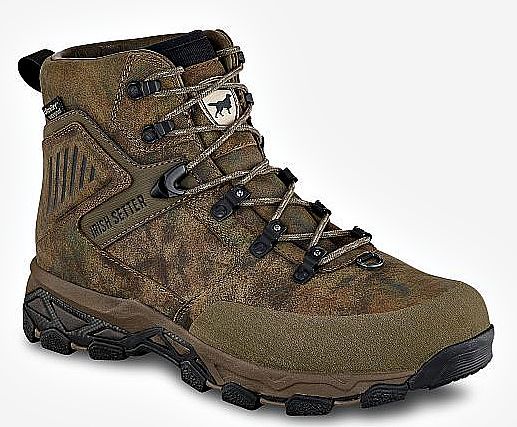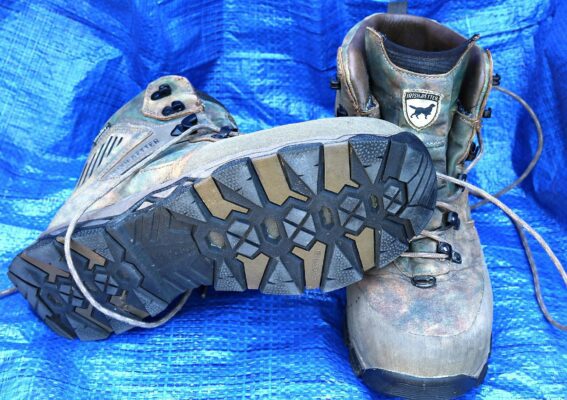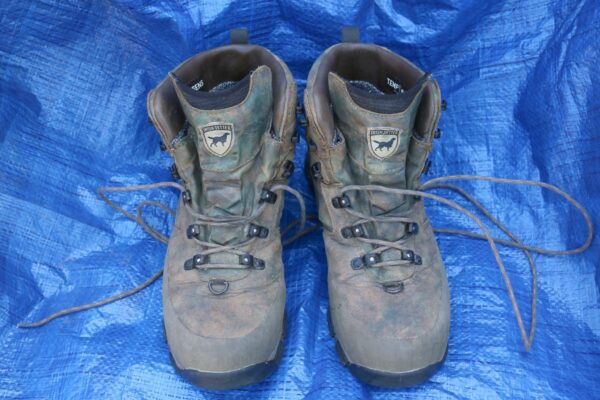My boot collection has any and all categories represented. This ranges from waterproof knee-high to quality flip-flops and everything in between. Footwear is matched to the situation.
But if I only had one set of boots to wear for everything, the choice would be simple: sturdy, ankle-high, non-insulated hikers with a fairly aggressive tread pattern on the sole. Like these Irish Setter Pinnacles.
by Leon Pantenburg
Disclaimer: Irish Setter supplied the product in this review. At the time of publication, there was no advertising or affiliate agreement between the company and Survival Common Sense. The following is my opinion, and nobody had any input in the review. All I ever promise is a fair shake.
Specialty boots excel in the niches they are designed for. Knee-high rubber boots, like Muck Boots, are intended for farm work, or for wading in water or other sewage-based organic liquid. Think barnyard. At the other end of the spectrum are sandals and flip-flops. These are useful when dry feet are not important and minimal protection is all that is necessary.

The Irish Setter Pinnacle 2700 is a solid boot for hunting, hiking and backpacking.
But the closest thing to do-it-all footwear, IMHO, is an uninsulated, non-waterproof, ankle-high boot with aggressive tread on the soles. This styles excels in warm and cool weather; as hunting footwear in rugged terrain and as backpacking hikers. When you’re walking much of the day, and the temperatures range from 30 degrees at dawn to 60 to 70 degrees at noon, you don’t really need a heavily-insulated boot. The comfort level and weight savings of these boots over heavily insulated footwear can be considerable. Combine these boots with the correct socks for the conditions and some quality insoles, and they can pretty much handle everything. Check out how to choose the best hunting boots.
For a backpacking boot, the sole should be sturdy and flexible, but semi-stiff. Carry a heavy pack through a boulder field and you’ll understand.

After 100+ miles of hiking, mostly on hot, rough pavement, the soles are starting to show a little wear. I’m guessing they’re good for another couple thousand miles.
It’s too early in the season to check out the Pinnacles in cold weather, but I did start wearing the Pinnacles in the August Mississippi heat and humidity. They have been broken-in walking with my dog every night. After about 20 miles in the park around the track, I pronounced them broken-in.
Recently, I went out in the swamp to do some checking on deer stands, and to do some scouting for whitetail sign. I am always foraging for wild edibles. I sweat completely through my go-to Beretta hot weather shirt and the sweat line went to the top of the crown of my mesh-sided broad-brimmed hat. None of my apparel was cool, but the boots were not extremely uncomfortable. The Pinnacles were as comfortable as any boot could be under those circumstances.
Here is what I know so far about the boots.
Here are the Pinnacle model 2700 specs:
Height: 7-inches
Leather Type: Nubuck, Waterproof
Footbed: Removable Memory Foam-PU Foam with ScentBan™ Odor Inhibitor
Shank: None
Outsole: ATC – Black-Brown
Last: VA-2219-1
Lining: Antimicrobial Lining
Country of Origin: Made in Vietnam
Here’s the good stuff:
Speed lacing system: I prefer a system where the laces don’t have to be inserted into an eyelet. This allows for a more precise loosening and tightening of the lace in specific areas. The pinnacles are easy to section-lace, and this allows for more comfortable walking as the terrain determines.
Tongue: CuShin™ comfort tongue technology helps minimize pressure on the shin from the top of the boot tongue. A four-way stretch nylon offers relief and flexibility while walking, the company claims, and an internal padded waffle mesh maintains premium comfort.
I really like this feature. The design allows easy tightening or loosening of different parts of the boot depending on where you’re walking. For example, on a recent hike with my dog, I cinched down the tongue over the arch, and left the ankles relatively loose. It resulted in more comfortable walking, and ankle support wasn’t needed on the sidewalk.

The lacing system is quick and precise.
On the other hand, for hiking in the mountains, I’d want to cinch down the arch to keep my heels from sliding around. I’d also tighten down around the ankles so I didn’t turn one on the rocks and boulders.
UltraDry™ waterproofing keeps you dry in wet conditions. I typically don’t like moisture barriers in hiking boots. My experience is that none of them work as advertised. But I did enjoy following a creek and wading in the shallow water with the Pinnacles while I did some rock-hounding. (Any time I’m outdoors I’m always looking for rocks and useful plants.) The jury is still out on this waterproofing.
TEMPSENS™ temperature regulating: I haven’t been able to check out boot comfort in cold weather yet. If it works as advertised, the Tempsens feature could be a really valuable asset.
According to the website: “This (Tempsens) technology reacts to your body temperature and sweat level to keep you dry and comfortable. When you’re hot, this technology cools you down by vaporizing moisture and removing body heat. And if you’re chilly it retains your body heat to keep you from getting too cold.”
ULTRADRY™ (from the website) construction combines a moisture management lining with waterproof components for dry, long-lasting comfort and performance.
After a several-mile hike, my wool socks were damp, but not soggy, and that was really as good as could be expected. It was HOT.
- ARMATEC™: “This technology (from the website) is a protective covering that is incredibly tough and abrasion resistant.”
- It feels tough, but I’ll have to wear these boots awhile to test the covering.




Leave a Reply